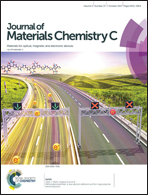Ln3+-Sensitized Mn4+ near-infrared upconverting luminescence and dual-modal temperature sensing†
Abstract
In the past few decades, efficient photon upconversion (anti-Stokes) luminescence has been extensively studied and is almost exclusively restricted to lanthanide (Ln3+) doped fluorophores. However, investigations on upconversion emissions of transition metal activators, whose (Stokes) luminescence is known to be tunable via modifying the crystal-field of the hosts, are extremely scarce. In the present work, a strategy to achieve Mn4+-based room-temperature near-infrared upconversion luminescence with the aid of efficient energy transfer of Yb3+ → Ln3+ → Mn4+ in specially prepared Yb3+/Ln3+/Mn4+ (Ln = Er, Ho, Tm):YAlO3 products is reported for the first time. Steady-state and time-resolved upconversion emission spectra are adopted to systematically clarify the related energy transfer mechanisms and determine energy transfer efficiencies. Benefitting from the completely different thermal-quenching mechanisms of Mn4+ and Ln3+ as well as the intermediate crystal field environment of Mn4+ in the YAlO3 host, the possibility of using a Mn4+/Ln3+-based dual-emitting upconversion fluorescence intensity ratio and Mn4+ upconversion lifetime as dual-modal temperature signals for accurate temperature sensing is demonstrated. It is believed that this preliminary study will offer a significant advance in exploring novel transition metal-based upconversion materials as well as self-calibrated optical thermometric media.



 Please wait while we load your content...
Please wait while we load your content...